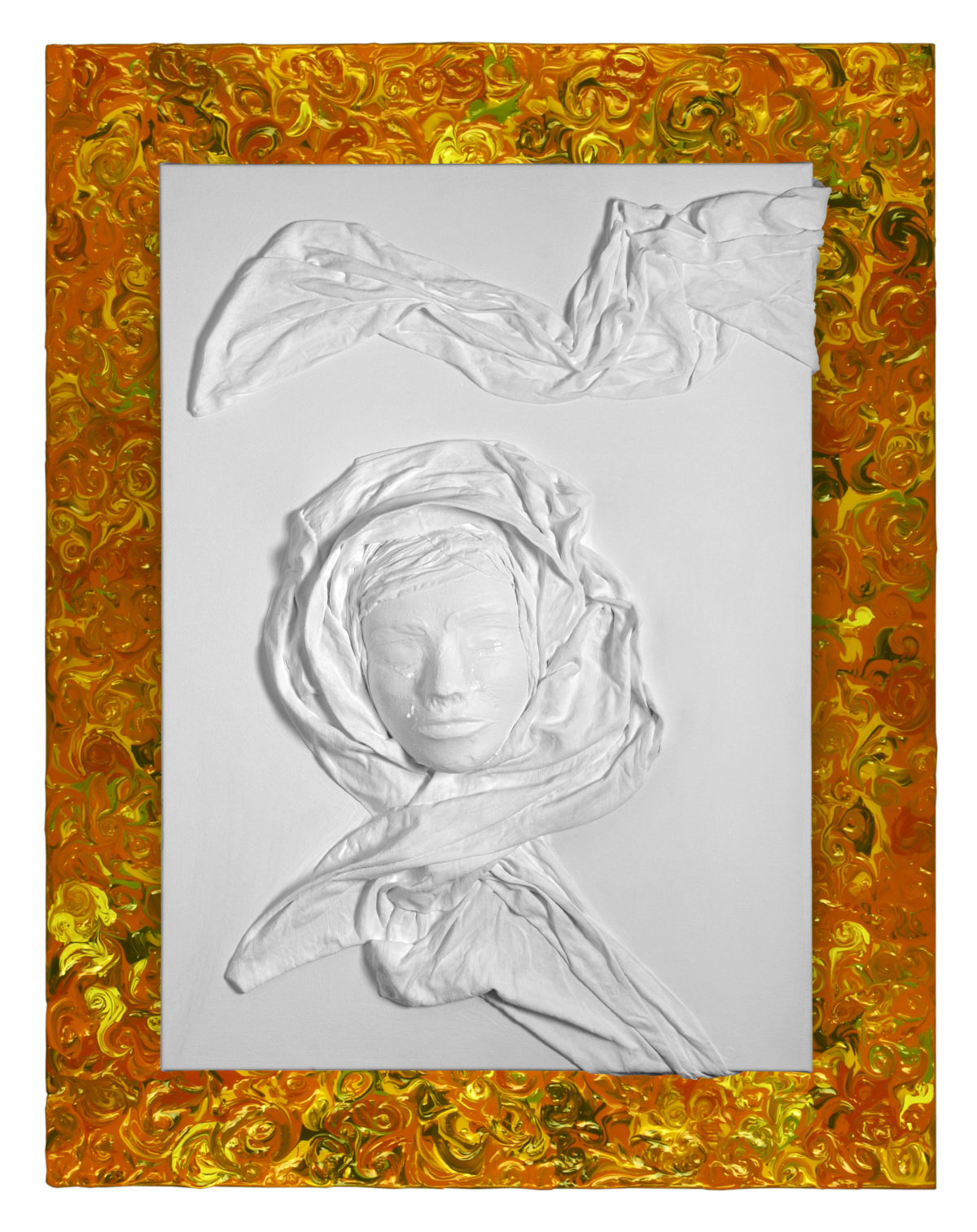
Canvasrelief
The motif is dedicated to Latifa, the first female pilot in Afghanistan.
As the first female helicopter pilot in the Afghan military,she did not shy away from risking her life and flew combat and
rescue missions against the Taliban.
She had to flee with her daughter. She now lives in Vienna.A poignant story of how she escaped the violence can be read
in her book “Reach for the Stars Sister”.
Colonel Latifa Nabizada, the first female pilot in the Afghan Air Force, is now adjusting to life in Austria after fleeing the Taliban. “I flew many services against the Taliban, and because of this I became a special enemy,” she explains. “Only by coincidence did I escape an attack. My rescue, and that of my daughter, happened because of the invitation to escape to Austria.”
As young girls growing up in Afghanistan, Latifa and her sister Laliuma talked about the stars and the universe and dreamed about flying. “We talked about how airplanes were made, what it would be like to fly one. How it would feel to be a pilot.”
After finishing school, they told their parents they wanted to be professional pilots. “I was very lucky to have caring parents who allowed us to get a good education, even though we were girls. The Soviets supported female education during their occupation on Afghanistan. Because of this, we could realize our desire for freedom. Without my sister, I wouldn’t have overcome the obstacles of becoming a pilot. As two, we were more courageous.”
The sisters were repeatedly denied admission to the military on medical grounds. They eventually joined in 1989 after being certified fit by a civilian doctor. There were no military uniforms readymade in the military for women, so they made their own.
“Our education took three years at the military academy in Kabul. In the first year we got solid general training in physics, math, geography and knowledge of weapons. The second year, we trained in aerodynamics, navigation and, above all, in techniques. We had to disassemble motors, rebuild them and learned what to do in case of emergency. This was important because of sabotage and theft of helicopter parts. More than once there were accidents and crashes because of technical problems or sabotage. It was necessary for survival to check the helicopter thoroughly and know everything right down to the last screws.”
After enduring prejudice in the classroom, including being hit with stones, Latifa and Laliuma moved on to flight training in the third year. “As a woman in Afghanistan, you feel less worthy than a man,” explains Latifa. “I had serious doubts about being qualified. However, in the theoretical education we proved that women can be better than men. After my first flight, my self-confidence grew because even my teachers had to confess that women had a good feel for flying and were capable helicopter pilots. We earned the respect of our male colleagues.”
Latifa remembers her first solo flight. “The training helicopter was an Mi-8 that had to be flown with co-pilots. After about 150 training hours, I made my first solo flight with my sister as co-pilot. It was the greatest feeling of freedom.”
In 1991, they graduated from helicopter flight school and began flying transport missions during the Afghan civil war. “I flew mostly transport services, taking supplies to combat areas and coming back with injured soldiers. Although these were dangerous flights, they were simply wonderful to fly. It was a form of freedom I did not otherwise have.”
In 1996, the Taliban seized Kabul, forcing the sisters to move to Mazar-i Sharif, a secure place in northern Afghanistan. After their hiding place was betrayed and their lives threatened, the family fled further to Pakistan. They kept a low profile, living in refugee camps and weaving carpets.
After the fall of the Taliban regime in 2001, the family returned to Kabul where Latifa and Laliuma were reinstated in the Afghan National Army Air Corps.
The sisters were each married in 2004, and both became pregnant in 2006. They continued to fly well into their pregnancies. While Latifa had no problem giving birth to her daughter Malalai, Laliuma died in childbirth. Latifa breastfed both Malalai and her niece Mariam.
Several month later, with Mariam in the care of her grandmother, Latifa returned to work. Since Latifa and her husband work and because childcare was not available, Malalai joined her mother on flights in the helicopter at the age of two months. “We were very cautions and only went together on routes we knew were secure.” Over the years Malalai joined her mother on hundreds of flights.
Once Malalai was old enough, she went to school. Latifa has since encouraged the military to provide childcare for women who are joining the military.
“I flew for the American Air Force for 18 years. I’m especially proud that I opened the door through my work as a female pilot for other Afghan female pilots. There are already other female pilots, like Niloofar Rhaman. It is important for me to show that women can reach their goals under adverse conditions. It is a difficult fight.”
Once again, facing death threats from the Taliban because of her flying, Latifa was forced to flee her home in Afghanistan. She is now living with her daughter in Austria. “My life has totally changed. I’m in a completely different culture and must restart. Almost everything is different here. The separation from my parents and relatives is very hard for me. I’m learning German and completed my English language certificate. Great new friends help me and give me hope. I’m a natural fighter and I’m convinced it’s time to face the world again.”
50 x 70 cm
Monika Stahl
+43 664 134 1672
atelier@MonikaStahl.at
Photos Heinz Schmölzer